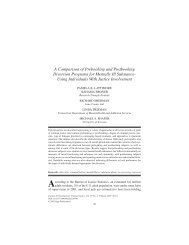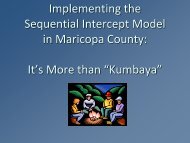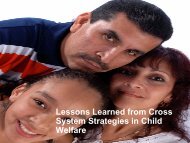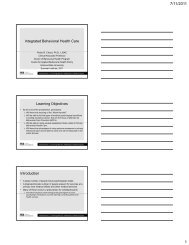Full presentaion - The Center for Applied Behavioral Health Policy
Full presentaion - The Center for Applied Behavioral Health Policy
Full presentaion - The Center for Applied Behavioral Health Policy
Create successful ePaper yourself
Turn your PDF publications into a flip-book with our unique Google optimized e-Paper software.
Beginning the Dialogue:<strong>The</strong> Importance of Partnering.ByLaura Henry, MSW & Stacia Ortega, BAArizona Department of <strong>Health</strong> Services/Office of Children with Special <strong>Health</strong> Care Needs & Division of <strong>Behavioral</strong> <strong>Health</strong> ServicesJanuary 2008
Today’s Overview• Why: Prepare <strong>for</strong> transition• What: Transition? Meaning?• Who: Youth/Family/Medical &<strong>Behavioral</strong> <strong>Health</strong> Professionals• When: Transition from theChildren’s system to the Adultsystem• How: <strong>Policy</strong> & Implementation
<strong>The</strong> National Numbers• 12.5 million children in the UShave special healthcare needs• 13.9% of all children nationwide• Growth of 30% over past 20years(SLAITS data 2007)MCHB definition of Children with Special <strong>Health</strong>careNeeds: “Those children who have or are at risk <strong>for</strong>chronic physical, developmental, behavioral, oremotional conditions and who also require healthand related services of a type or amount beyond thatrequired by children generally.”
Arizona’s Numbers• OCSHN• 201,608 children/youth withspecial needs in AZ (age 0-17)• 12.5% of all AZ’s children• 13% of these families haveincome levels 200%-399% belowfederal poverty level• 13% of these families haveincome levels 400% or morebelow federal poverty level• 11.3% of families spent 11 hoursor more per week providing orcoordinating their child’s care• 20.2% of families faced financialproblems due to youth’scondition• 23.1% of families either had toreduce work hours or stopworking due to their youth’scondition(SLAITS data 2007)• DBHS• 38,442 children enrolled• 25% of Latinos living inpoverty• 25% of the population isLatino• 6,329,482 population ofArizona• 1,732,204 Under the age of20
What does transition mean?• Deliberate guidance with a<strong>for</strong>malized plan• Inclusive of both the youth and theirparent• Holistic in nature and emphasizesboth medical and non-medicalaspects of a youth’s life• For the youth, the family, and theclinic and medical staff?
Transition questionsWhen does it begin?Who is involved?How is it guided?
Children’s system to AdultSystem
• FinancialTransition dialogue: What• Transportation• Medical• Housing• Educational &Vocational• Social• <strong>The</strong> What ifs*needs to occur?
Financial Transition• Is the youth aware of which health care benefits endat age 18 and age 21?• Does the youth and family have a plan <strong>for</strong> continueddental, vision and health care coverage?• Does the parent need to consult with their employer<strong>for</strong> continued health care coverage <strong>for</strong> youth(dependent disabled adult status)?• Has the youth and family applied <strong>for</strong> Social Securitybenefits at age 18?• Has the parent established a special needs will ortrust to cover the youth’s future medical care?• Will the youth need a public fiduciary to handle hisfinances?
Transportation Transition• Does the youth want to be independentlymobile in their community?• Does he have access to the communityservices/supports needed toincrease/improve community participation(i.e. public transportation, adaptivevehicles, other specialized transportationservices)?• In what areas will the youth needassistance with transportation (i.e.shopping, school, medical appointments,etc)?
Medical Transition I• What is the youth’s understanding of his/hermedical condition?• Can the youth take independent responsibility <strong>for</strong>medications, understand the reasons <strong>for</strong> them andknow how to refill them?• Can the youth identify signs/symptoms of hismedical condition and the need <strong>for</strong> medicalattention?• How familiar is the youth with his medical suppliesand how to obtain repairs and additional supplies?• Can the youth communicate directly with hishealthcare providers by scheduling his ownappointments?• Can the youth consent to his own medical care ifover age 18?
Medical Transition II• What are the long-term plans to prepare <strong>for</strong> adultmedical care?• Has the youth and family identified any adultproviders?• Does the youth have a portable medical summary<strong>for</strong> the new adult provider?• Is a <strong>for</strong>mal plan being developed that would addressthese questions?• Does the plan include specific goals and objectives?• Does the youth and family receive a copy of thisplan?
Housing Transition• Who will the youth live with andwhat living arrangements are beingconsidered (i.e. independent, with afriend, in a dormitory on a collegecampus, in a group home, at homewith his family or other familymembers, in a specialized carefacility)?• What supports will be needed <strong>for</strong> anyof these living arrangements to besuccessful <strong>for</strong> both the youth and theparents?
Educational &Vocational Transition I• Has the IEP team begun to discusstransition out of the school environment?• Have transition goals been added to the IEPor 504 Plan?• What assistive technology is needed tomake transition successful?• If the youth plans to attend post-secondaryeducation, have their options beendiscussed? (4-year college, communitycollege, or vocational training program)• What services are available on the collegecampus to assist a person with disabilities?
Educational &Vocational Transition II• Has the IEP team begun to discuss plans<strong>for</strong> employment and what setting would bemost appropriate <strong>for</strong> the youth (i.e.independent, supported, or shelteredemployment)?• If the youth plans to work after high school,has he identified a career of interest andhow will the IEP goals support pursuit ofthis career?• If the youth does not plan to work orpursue employment, has the familyidentified alternative settings such as a daytreatment or habilitative program?
Social and RecreationalIssues• Has the youth identified specificrecreational or social activities ofinterest?• What supports are needed to assistthe youth in participating in theseactivities?
<strong>The</strong> What If’s?• Is legal guardianship needed and does theparent know when and how to complete theprocess?• Is a medical power of attorney needed?• Who will take responsibility <strong>for</strong> the youth’smedical condition if the parent dies orbecomes incapacitated? Has this personbeen identified in legal documents?
Special <strong>Health</strong> Care NeedsCase Example• 14 year-old female with spina bifida andshunt• Uses manual wheelchair as sole source ofmobility• Caths 4 times/day• Not affected cognitively by diagnosis• Lives with both parents and one youngersiblingWHAT WILL TRANSITION LOOK LIKE FORTHIS YOUTH?
Special <strong>Health</strong> Care NeedsCase Example• 17 ½ year-old male with spasticquadriplegia, epilepsy, severecognitive disability• Requires total care (feeding,bathing, dressing, decisionmaking)• Lives with single mother and 3younger siblingsWHAT WILL TRANSITION LOOKLIKE FOR THIS YOUTH?
<strong>Behavioral</strong> <strong>Health</strong> Example• 17 year-old with co-occurring substanceabuse and recently diagnosed withschizophrenia• Placed on “JIPs” (Juvenile IntensiveProbation) until 18 th birthday• Removed from home and placed withrelatives• Has a CFT (Child and Family Team) inplace• Attending alternative high schoolWHAT WILL TRANSITION LOOK LIKE FORTHIS YOUTH?
Principles of Youth &Family-<strong>Center</strong>ed Care• Recognize the family is the constant in the youth’s s life. <strong>Health</strong>care providers may change over time• Facilitate youth/family and professional collaboration at alllevels in health care• Honor the diversity of youth and their families• Recognize youth/family strengths• Share complete and unbiased in<strong>for</strong>mation• Promote youth-toto-youth and family-toto-family support andnetworking• Implement comprehensive policies and programs• Design accessible health care systems thatare flexible, culturally competent, and responsive toyouth/family needs
~<strong>The</strong> 12 Principles~Providing a Guide through theChildren’s System of Care• 1.Collaboration with the Child andFamily• 2. Functional Outcomes• 3. Collaboration with others• 4. Accessible Services• 5. Best Practices• 6. Most Appropriate Setting• 7. Timeliness• 8. Services tailored to the Child & Family• 9. Stability• 10. Respect <strong>for</strong> the Child and Family’sUnique Cultural Heritage• 11. Independence• 12. Connections to Natural Supports
No 25731 Gaceta Oficial Digital, martes 13 de febrero de 200723q) Se prohíbe alimentar a los cetáceos.Capítulo VFinanciamientoDÉCIMO SEXTO: Los fondos que se recauden en concepto de pagos realizados por las actividades de turismo deavistamiento, licencias, permisos y certificaciones de guías, se destinarán para el funcionamiento del Corredor Marino, através de la Autoridad de los Recursos Acuáticos de Panamá, los cuales serán distribuidos entre los siguientescomponentes: divulgación y educación ambiental, programas de capacitación, investigación de los mamíferos marinos,costos administrativos y operativos relacionados con el funcionamiento del Comité Directivo del Corredor Marino, la RedNacional de Varamiento y costos operativos del Servicio Marítimo Nacional relacionados con el cumplimiento de la Ley13 de 2005.La Autoridad de los Recursos Acuáticos de Panamá incluirá, dentro del presupuesto general de funcionamiento de lainstitución, las partidas correspondientes para este fin, de con<strong>for</strong>midad con los ingresos que la actividad vaya generando.DÉCIMO SÉPTIMO: El Comité Directivo coadyuvará en la promoción y desarrollo de programas de financiamientoinicial (capacitación, prestamos) orientados al desarrollo de actividades relacionadas directa e indirectamente con elecoturismo de avistamiento de cetáceos, con miras a beneficiar económicamente a las comunidades ubicadas en áreasadyacentes a la Zona del Corredor Marino donde éstos se desarrollan.Capitulo VIFiscalizaciónDÉCIMO OCTAVO: La Autoridad de los Recursos Acuáticos de Panamá, a través de la Dirección General deInspección, Vigilancia y Control, en conjunto con el Servicio Marítimo Nacional, realizará operativos de fiscalización enlas áreas donde se realicen actividades de avistamiento de cetáceos.Parágrafo: El Servicio Marítimo Nacional podrá realizar de manera independiente acciones de fiscalización durante eldesarrollo de sus funciones.Capitulo VIISancionesDÉCIMO NOVENO: La Autoridad Marítima de Panamá a través de la Dirección General de Inspección, Vigilancia yControl supervisará, fiscalizará y sancionará las violaciones que se cometan al presente reglamento, sin perjuicio de laresponsabilidad que recaiga sobre el infractor por las violaciones a la legislación vigente sobre esta materia.Las violaciones al presente reglamento serán sancionadas de con<strong>for</strong>midad con las leyes y reglamentos vigentes.Capítulo VIIIDisposiciones TransitoriasVIGÉSIMO: La Dirección de Recursos Marinos y Costeros de la Autoridad Marítima de Panamá deberá ejercer lasfunciones de que trata la presente resolución en relación a la Dirección General de Ordenación y Manejo Integral y laDirección General de Inspección, Vigilancia y Control de la Autoridad de los Recursos Acuáticos de Panamá, mientrasesta Dirección General no sea transferida <strong>for</strong>malmente a la Autoridad de los Recursos Acuáticos de Panamá (ARAP) enlos términos que estipula la Ley No. 44 de 23 de noviembre de 2006.Capítulo IXVigenciaVIGÉSIMO PRIMERO: La presente resolución comenzará a regir a partir de su publicación en la Gaceta Oficial.
Youth & Family• Youth Voice• Family Voice• Impact ofCulture• Different viewsof independence• Role of familyafter 18• Reassuringfamily of theirrole after youngadult turns 18Partnership
What are we doing now• OCSHCN• DBHS• Protocols• Training• NationalConferences• StatewideTransition• System of CarePlans
Many Thanks <strong>for</strong> yourattendance todayContact us:Laura Henryhenryla@azdhs.gov&Stacia Ortegaortegas@azdhs.gov










